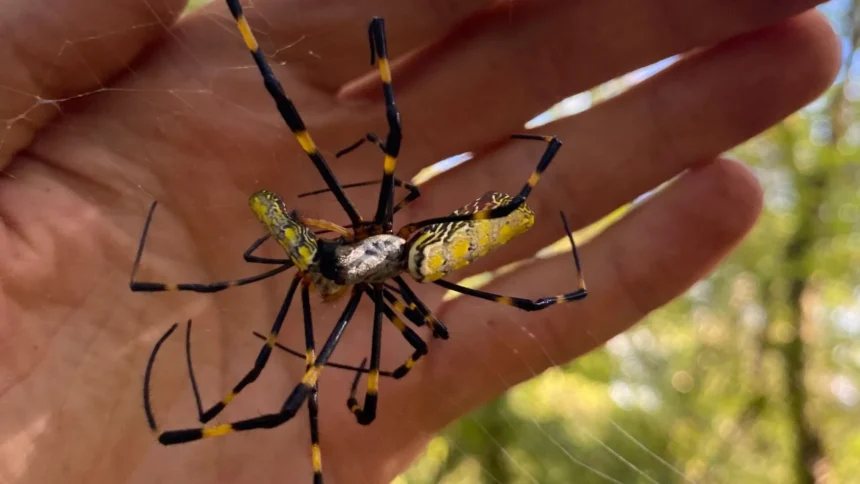A recent study has discovered a species of giant spiders with yellow and blue-black colors on their bodies, which may appear intimidating but are the “shyest” ever documented. Known as jorō spiders (Trichonephila clavate), these spiders have been introduced in the southeastern United States. Researchers from the University of Georgia observed that these spiders, along with their cousin species, Trichonephila clavipes or golden silk spiders, remain motionless for over an hour after a stimulus, unlike most other spiders that freeze for less than a minute when provoked. This unique behavior, published in the journal Arthropoda on May 15, 2023, suggests that spiders of the Trichonephila genus are exceptionally timid.
Jorō spiders construct exceptionally large webs, spanning from one to two meters in diameter, which can be found on bushes, trees, and even human dwellings. The study also revealed that jorō spiders have a high tolerance for human-modified environments. The lead author, Andrew K Davis, observed numerous webs made by this species, connected by support strands, forming a “colonial web.” This indicates that jorō spiders are invasive and opportunistic.
The study aimed to understand the behavior of jorō spiders in their introduced range, assess their response to perceived threats, and examine their tolerance to human disturbances. The researchers collected mature females of Trichonephila clavate and Trichonephila clavipes, as well as three other orb-weaving spider species common in Georgia. They evaluated the spiders’ immobility duration after experiencing mild disturbances, such as a brief puff of air.
Comparing the “air puff response” data with previous studies on five other North American spider species, the authors obtained a total of 453 observations of freezing behavior. Both Trichonephila species exhibited an exceptionally prolonged response known as thanatosis or death-feigning, lasting over an hour after mild stressors, in contrast to other spider species whose freezing behavior lasted only a few minutes. Thanatosis is a temporary state of motor inhibition triggered by extreme fear and serves as an anti-predator strategy in various prey species.
The researchers noted that the prolonged thanatosis response observed in Trichonephila spiders is unprecedented compared to previous studies. While most other spiders freeze for one to two minutes, these spiders remained motionless for over an hour. The study suggests that this extended response to perceived threats may be a unique defensive strategy that has evolved in Trichonephila spiders due to the increased predation within their colonial webs compared to solitary webs. The authors ruled out “large body size” as the sole reason for the spiders’ prolonged freezing behavior, as similar-sized Argiope spiders do not exhibit such a response.
The authors find the surprising behavior exhibited by Trichonephila spiders noteworthy, considering their ability to tolerate urban landscapes. They describe these spiders as having an “extremely shy” and “non-aggressive” personality. The study concludes that the spiders’ immobility for extended periods allows them to tolerate continuous disturbances in urban environments by remaining motionless, rather than fleeing.


